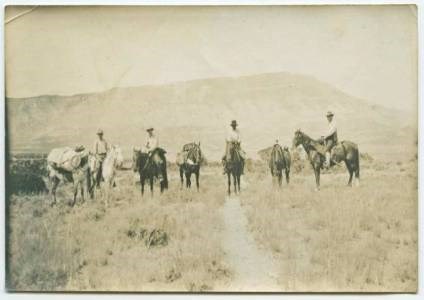
NPS Rich With Possibilities Undeterred, Barry believed the land in and around his homestead was still rich with possibilities. He turned his efforts towards exploiting the recreation potential of the area. Hunting, fishing, hiking, boating and overnight excursions would hopefully be the calling card for Barry’s newly founded Cedarvale Dude Ranch. The Trip of a Lifetime Yet brochures and promotional literature from the railroad only went so far. Barry needed to make even bigger news. He wanted to market his ranch to a national audience. That’s when Barry, along with his stepson Claude St. John, hit upon the idea of a headline making river voyage. Using, the Edith, an 18 foot, two cylinder, eight horsepower motor boat, Barry, St. John and close friend Delbert Smith would make the trip of a lifetime. Putting in on the Bighorn, at what is today known as Barry’s Landing, the adventurers would make their way first through the treacherous waters of the canyon, ascend the Bighorn, and move upstream on the Yellowstone. From the Yellowstone they would float into the Missouri, navigating the longest waterway in North America. Then they would make their way to St. Louis, and converge with the mighty Mississippi. The final leg of their trip, would take them downriver to New Orleans. It seemed like a great idea. The only problem, the toughest part of the trip would take place at the start, floating Bighorn Canyon. Narrow Escapes According to Barry’s reminiscences, “we had may (sic) narrow escapes, as the boat seemed almost to touch rock after rock as she dipped her bows into the eddies, while the turbulent waters threw the spray so thick at times that the other occupants of the boat could not be seen by the writer who had the ‘wheel’ near the stern.” Claude St. John kept a diary during the trip. His entry for the first day, reinforces Barry’s sentiments: “Engine went dead Jumped in a hole and out again. Drowned the engine and ignition. Swamped the boat half a dozen times and had to hand bail her out some water. Camped a mile below Black canyon Our cat quit us but the dog stayed wit(sic).” Yet after the initial tough start the trip began to go smoothly. By June 2nd, they had arrived in Hardin, Montana, only 45 miles from the confluence with the Yellowstone. Claude paints a picture of Hardin as a colorful frontier community: “Met all kind of fellows. The blacksmith did some work for us and was decent in his prices. The rest of them skin you of all they can. Saw a fellow named King that had lots of money and all he had to do was loaf and lie…Stayed both night with an old fellow at the pump house. He was pretty good to us.” Mighty and Muddy By July 15th, the Edith was on the verge of St. Louis. That evening they met the roiling waters where the Missouri and Mississippi converge. Claude related, “You could see some difference in the water before they mixed. The Misiouri (sic) you could cut with a knife and the Mississippi was as clear as crystal. It didn‘t stay that way long after the Missouri (sic) hit it.” The trip down the Mississippi was relatively smooth save for the food Claude commented on in several entries. On July 19th in New Madrid, Missouri: “ About the worst town we have struck on the run. We went into a restaurant and came away hungry. The feed they gave you was something fierce.” At Arkansas City on July 25th: “Doc came back with six pies for a quarter that were nothing but crust and that was mighty poor.” Safe and Sick Claude would spend a couple of months with relatives in New Orleans before he finally recovered. Barry and Smith would soon return to Cedarvale. Their efforts paid off. The trip made headlines, generated interest and the ranch hosted guests from around the nation into the late 1920s. Barry also started the “Big Horn Motor Boat and Outing Co.” with a fleet of six boats to lead visitors on river runs. A Fitting Monument 
NPS |
Last updated: June 8, 2022
